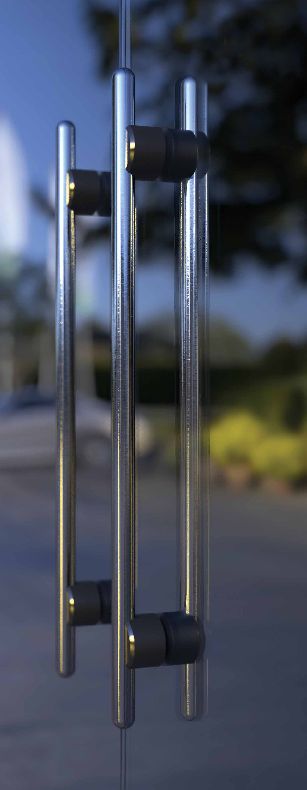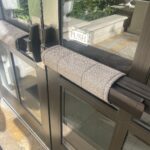 Most of you know that hardware used to operate a door on an accessible route must be mounted between 34 inches and 48 inches above the floor. In California, the allowable range is 34 inches to 44 inches. But does the ENTIRE piece of hardware have to be mounted within that area?
Most of you know that hardware used to operate a door on an accessible route must be mounted between 34 inches and 48 inches above the floor. In California, the allowable range is 34 inches to 44 inches. But does the ENTIRE piece of hardware have to be mounted within that area?
As with many issues related to hardware, this is not specifically addressed in the codes and standards – which means that the final determination would be made by the Authority Having Jurisdiction (AHJ). But let’s look at this from a common-sense standpoint.
For some types of hardware – like lever handles, touchpads and crossbars on panic hardware, and extended-length thumbturns – the portion of the hardware used to retract the latch must be mounted within the allowable range. I think the intent is pretty clear for these products, but the question has come up a lot lately with regard to two other types of hardware:
- Long Door Pulls – According to the Door & Hardware Institute’s document – Recommended Locations for Architectural Hardware, the standard location for the center of a door pull is 42 inches above the floor. If a 10-inch-high pull is mounted at this height, the entire pull will be in the area between 34 inches and 48 inches above the floor. But many pulls used today are longer – even “full-height”. In my opinion, the intent of the codes and standards is that a usable portion of the pull would need to fall into the allowable range – not the entire pull. An AHJ may disagree with me (fair warning), but I think having enough of the pull for someone to use at the accessible height meets the intent. How much of the pull needs to be “in the zone”? Again, this would be up to the AHJ but depending on the design of the pull it seems like 4-6 inches would be sufficient. Remember – this is my interpretation based on experience, since there is no prescriptive language in the codes and standards to address this.
- Keypads, Push Buttons, and Other Access Control/Security Components – This is a tough one, and I can’t make an official determination. Some would argue that a push button on an electrified lock for access control is exempt from the mounting height requirements because of the International Building Code (IBC) exception stating: “Locks used only for security purposes and not used for normal operation are permitted at any height.” The ADA also has an exception to the mounting height IF the door is designed to be operated only be security personnel – an advisory reiterates that security personnel must have sole control of doors that are eligible for this exception. Many of these access control components are used on a regular basis by people who are not security personnel, which would mean that if the component is considered operable hardware, it would have to be mounted within the allowable range. This can be especially difficult given the California limitation. Again – this would be up to the AHJ since it is not specifically addressed in the codes and standards, but it’s definitely something to watch out for.
.
If you have run into this question and received a directive from the AHJ, I’d love to hear about it!
You need to login or register to bookmark/favorite this content.






On the Long Door Pulls, i think there will also be a problem of “Tight Grasping” to open/pull the door.
Section 404.2.6 in ICC-ANSI A117.1-2009 says in part, “Door Hardware. Handles, pulls, latches, locks, and other operable parts on accessible doors shall have a shape that is easy to grasp with one hand and does not require tight grasping, pinching, or twisting of the wrist to operate. Operable parts of such hardware shall be 34 inches (865 mm) minimum and 48 inches (1220 mm) maximum above the floor.” The requirement then is for operable parts to be in the range of 34 to 48 inches.
What about the part of the code that say “No projection into the clear width is permitted below 34.” wouldn’t this exclude full height pulls on ADA entrances.
Hi Brendan –
Here’s the complete section from the IBC: 1010.1.1.1 Projections into clear width. There shall not be projections into the required clear opening width lower than 34 inches (864 mm) above the floor or ground. Projections into the clear opening width between 34 inches (864 mm) and 80 inches (2032 mm) above the floor or ground shall not exceed 4 inches (102 mm). Exception: Door closers and door stops shall be
permitted to be 78 inches (1980 mm) minimum above the floor.
Below 34 inches, the projections are limited into the REQUIRED clear opening width. So whether or not a full-height pull (on the push side) is a problem depends on how much ACTUAL clear opening width there is, and how far the pull projects into it. For example, if you have a 4-foot-wide door and a pull that projects 3 inches, it does not project at all into the required clear width of 32 inches. If you have a 3-foot door hung on standard hinges or pivots, the pull probably projects into the required clear width – that’s a problem. You also have to watch out for the bottom 10 inches on the push side, where no projecting hardware is allowed, even based on the 4-foot-door example.
I hope that makes sense.
– Lori
I am pretty sure I understand it..
So if I am doing the math correct, say I have an 1 3/4″ door, with a 1/4″ BS on a 4 1/2″ Standard Butt hinge anything over 7/8″ would decrease the 32″CW to non-compliances, figuring the item is at least 10″AFF.